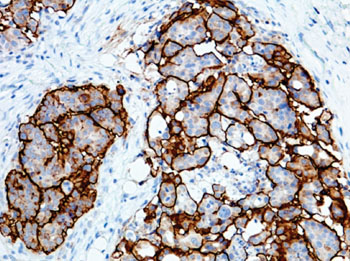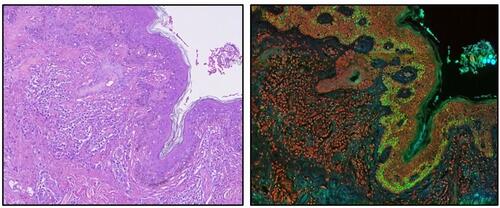Test Model Discriminates Ovarian Tumors
By LabMedica International staff writers
Posted on 29 Oct 2014
A new test can discriminate between benign and malignant ovarian tumors, and identify different types of carcinomatous tumors, with a high level of accuracy.Posted on 29 Oct 2014
An accurate specific diagnosis of adnexal tumors before surgery will almost certainly improve the triage of patients and so increase the likelihood that patients will receive appropriate treatment.

Image: Immunohistochemical staining of ovarian tissue with anti-CA125 for the diagnosis of ovarian carcinoma; the neoplastic cells are strongly stained (Photo courtesy of Epitomics).
An international team of scientists led by those at Katholieke Universiteit Leuven (Belgium) and the Imperial College London (UK) developed the test using data from 3,506 patients from 10 European countries from 1999 to 2007, that looks at which information available before the operation could be used to predict the diagnosis. They then tested the model on a further 2,403 patients between 2009 and 2012.
The test was the Assessment of Different NEoplasias in the adneXa (ADNEX) model that contains three clinical and six ultrasound predictors: age, serum CA-125 level, type of center (oncology centers versus other hospitals), maximum diameter of lesion, proportion of solid tissue, more than 10 cyst locules, number of papillary projections, acoustic shadows, and ascites.
Participating centers were encouraged to measure serum cancer antigen 125 (CA-125). They used second generation immunoradiometric assay kits for CA-125 II from several companies including Roche Diagnostics (Basel, Switzerland) , Centocor (Malvern, PA; USA), Cis-Bio (Codolet, France), and six other manufacturers. All these kits used the OC125 antibody. The reference standard was the histopathological diagnosis of the mass after surgical removal by laparotomy or laparoscopy.
The ADNEX model satisfactorily discriminated between benign and malignant tumors and offers fair to excellent discrimination between four types of ovarian malignancy. The use of ADNEX has the potential to improve triage and management decisions and so reduce morbidity and mortality associated with adnexal pathology.
Tom Bourne, MD, PhD, a professor of Surgery and Cancer, and a senior author of the study said, “It's very important to get the preoperative diagnosis right. If it isn't right, the patient might have a more extensive operation than they need, for example having an ovary removed unnecessarily. If a tumor is benign, a woman might not need any treatment at all. If it is malignant, you need to know what type of tumor it is to choose the best treatment and that treatment needs to be carried out by specialist gynecological cancer surgeon.” The study was published on October 15, 2014, in the British Medical Journal.
Related Links:
Katholieke Universiteit Leuven
Imperial College London
Roche Diagnostics













